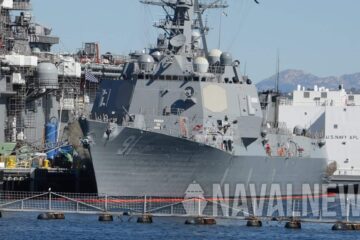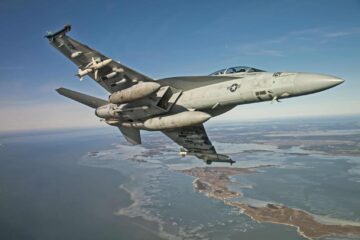By Mass Communication Specialist 3rd Class Zachary Melvin – USS Gerald R. Ford Public Affairs
During ISE 17, Ford accomplished carrier qualifications (CQ) for Fleet pilots and student naval aviators (SNAs), conducted Combat Systems Ship’s Qualification Trials (CSSQT) phase 2A, and integrated carrier strike group operations.
Capt. Paul Lanzilotta, Ford’s commanding officer (CO), gave insight to his first underway as Ford’s CO:
“This underway period has been fantastic for me and the crew. We really did the job with incredible precision and an extra level of complexity – the crew of Warship 78 managed multiple high priority events as a team and was able to meet our mission requirements every single day. It was a special honor to demonstrate the crew’s excellence for the Acting Secretary of the Navy, the Honorable Thomas W. Walker, during his visit.”
During the first portion of ISE 17, Ford contributed to fleet readiness by conducting CQ for 14 pilots assigned to Strike Fighter Squadron (VFA) 122 and three pilots assigned to Carrier Airborne Command and Control Squadron (VAW) 124. The carrier landings, or “traps”, during ISE 17 CQ periods increased Ford’s current trap count to 7,879 utilizing the ship’s first-in-class advanced arresting gear.

Lt. j.g. Kyle Briggs, from Omaha, Nebraska, a pilot assigned to VFA-122, explained that his CQ was partially completed with the use of an advanced landing mode:
“We used precision landing mode for this FRS [fleet replacement squadron] CQ but not with the T-45’s. T-45s was all manual passes, so we are getting used to a different way of flying. What is different [about Ford] is the whole entire arrested landing gear system, just getting used to that stuff and relying on the engineers that do their job, which they have.”
Ford’s combat systems department completed phase 2A of CSSQT, a Naval Sea Systems Command requirement for ships that are either new construction or have undergone a significant combat systems upgrade. During the qualification trials, the close-in weapons system (CIWS) fired 1,500 rounds of ammunition and successfully engaged a low-cost modular target. Combat systems department Sailors also conducted 349 hours of routine maintenance on seven defensive weapon systems, to groom them for CSSQT phase 2C.
“Doing CSSQT allowed us to gauge our ability to defend the ship,” said Fire Controlman 2nd Class Tyler Westbrook, from Fort Huron, Michigan, assigned to Ford’s combat systems department. “We have our aircraft launch and recovery as our offensive. CIWS, rolling airframe missiles and NATO sea sparrow allow us to see what it is like defending the ship.”
SNAs assigned to Chief, Naval Air Training Command (TRACOM) also conducted CQ to complete required training to earn their “wings of gold”. Ford has qualified 167 SNAs since March 2020, including 28 during ISE 17.
Lt. Christopher Jones, from Paintsville, Kentucky, Ford’s aircraft handling officer, said that Ford’s air department executed the TRACOM CQ mission well above standards.
“The entire air department performed exceptionally well during TRACOM CQ. The ability of Ford to safely and efficiently conduct CQ operations has tremendously impacted the readiness of naval aviation.”
Wrapping up ISE 17, Carrier Strike Group (CSG) 12 Commander, staff, and warfare commanders embarked aboard Ford to execute integrated carrier strike group operations. Over a one week period they conducted an encounter exercise with USS Stout (DDG 55), an expendable mobile anti-submarine warfare exercise with the “Spartans” of Helicopter Maritime Strike Squadron (HSM) 70, and an emissions control exercise lead by the Information Warfare Commander.
Gerald R. Ford (CVN 78) is in port Naval Station Norfolk for a scheduled window of opportunity for maintenance as part of her post-delivery test and trials phase of operations, and is on schedule for full ship shock trials later this year.






